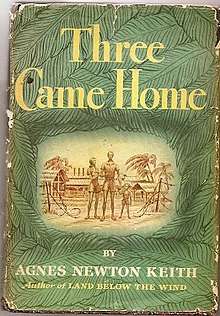Three Came Home (book)
Three Came Home is a 1948 memoir written by Agnes Newton Keith, based on her experiences during the Japanese invasion of North Borneo. A film based on it was released in 1950 and featured Claudette Colbert in the lead role.[1] Initially, Olivia de Havilland was chosen for the role.[2] Originally published in 1948 by London publisher Michael Joseph, it was republished by Eland in 1985, and Eland released a new edition in 2002.[3]
 First edition | |
| Author | Agnes Newton Keith |
|---|---|
| Illustrator | Don Johnston |
| Country | United States |
| Language | English |
| Genre | Memoir |
| Set in | Borneo |
| Published | 1948 |
| Publisher | Boston : Little, Brown and Co. |
| OCLC | 394895 |
| Preceded by | Land Below the Wind |
| Followed by | White Man Returns |
Background
Keith had previously written Land Below the Wind. Her husband, Harry Keith, was Conservator of Forests and Director of Agriculture in North Borneo.[4] Their son George was born in 1940.[5] When the Keiths were living in Borneo, it was attacked by the Imperial Japanese Army and they were interned there from January 1942 to September 1945.[6][7] During her internment at Kuching Internment camp along with her son George, Keith suffered from malaria and typhoid.[8] Her husband Harry was kept in a civilian men's camp.[9]
Summary
Women had to work very hard. When a Lt. General was to visit the camp, Commander Nekata orders the women to clear a strip of land where formerly rubber trees were grown and plant potato cuttings. They work the whole night and Nekata gets promoted when the Lt. General visited but the potato cuttings died very soon.[8] At the camp, Keith is assaulted by a guard and also tortured. This results in a twisted arm and broken ribs.[9] The Japanese are aware that she was a writer and is occasionally given a little extra food.[7] Australian soldiers interned in a nearby camp send $50 to the women's camp through a Roman Catholic priest. Though initially they did not want to take the money, they later accepted and sent a letter of thanks to them.[8] The condition of women is very poor and lack of sanitation and proper food made many of them sick.[9] When Tatsuji Suga met her, he ordered her to write The Life and Thoughts of an Internee. She agreed but titled her work Captivity. She prepared notes separately for another work in minute handwriting on margins of old newspapers, reverse of labels and Chinese tobacco papers. She hid them in George's toys, pillows, sleeping mat and also in tins.[10]
Reception
W. G. Rogers called the book "sometimes shocking and often inspiring".[7] Laura Scott Meyers wrote that the book "[was] a detailed and unvarnished account of what war was like for internees and prisoners of war".[9] It was chosen by The Book of the Month Club as its Book of the Month for April 1947.[11][12] David Judy praised Keith's humor and wrote that the book gave "a sense of what a truly successful marriage can be like even though the worst of circumstances arise."[4] Joe Langston noted that "[Keith's] writing [was] strangely free from any hate of a particular people".[13] Dorothy Canfield Fisher praised the book by saying "To read this book is like living through an experience rather than just reading about it".[14] Joyce Nienstedt wrote that it was much more than a war book.[14] Louise Parks Banes opined that "No more gallant story has ever been written than Three Came Home.[15] According to The Gallup Independent, "[Keith's] account [was] one of the most stirring which has come out of the war".[16]
References
- Corby, Jane (21 February 1950). "Screenings". The Brooklyn Daily Eagle. Brooklyn, New York. p. 6. Retrieved 12 April 2015 – via Newspapers.com.

- Hopper, Hedda (30 October 1948). "Three Came Home is Next Olivia de Havilland film". The Evening News. Harrisburg, Pennsylvania. p. 4. Retrieved 12 April 2015 – via Newspapers.com.

- "Three Came Home". Eland Books. Retrieved 14 September 2016.
- Judy, David (20 April 1947). "Book of the Week". The Times Recorder. Zanesville, Ohio. p. 16. Retrieved 12 April 2015 – via Newspapers.com.

- Robinson, Maude (1 June 1947). "New Epic Tempts Readers". The Salt Lake Tribune. Salt Lake City, Utah. p. 41. Retrieved 12 April 2015 – via Newspapers.com.

- "Three Came Home by Agnes Newton Keith". The Waxahachie Daily Light. Waxahachie, Texas. 6 April 1947. p. 1. Retrieved 12 April 2015 – via Newspapers.com.

- Rogers, W. G. (9 April 1947). "Literary Guidepost". Corsicana Daily Sun. Corsicana, Texas. p. 8. Retrieved 12 April 2015 – via Newspapers.com.

- McKarn, Robin (31 March 1947). "Reading & Writing". The Daily News. Huntingdon, Pennsylvania. p. 12. Retrieved 12 April 2015 – via Newspapers.com.

- Meyers, Laura Scott (11 April 1947). "The Book Shelf". El Paso Herald-Post. El Paso, Texas. p. 3. Retrieved 12 April 2015 – via Newspapers.com.

- "Three Came Home". Estherville Daily News. Estherville, Iowa. 17 May 1947. p. 4. Retrieved 12 April 2015 – via Newspapers.com.

- "Book News". The Daily News. Huntingdon, Pennsylvania. 25 January 1947. p. 5. Retrieved 12 April 2015 – via Newspapers.com.

- "Three Came Home in Library Stacks". Joplin Globe. Joplin, Missouri. 27 April 1947. p. 19. Retrieved 12 April 2015 – via Newspapers.com.

- Langston, Joe (26 April 1947). "Library Notes". Dixon Evening Telegraph. Dixon, Illinois. p. 8. Retrieved 12 April 2015 – via Newspapers.com.

- Nienstedt, Joyce (26 April 1947). "This Week At the Library". Iowa City Press-Citizen. Iowa City, Iowa. p. 3. Retrieved 12 April 2015 – via Newspapers.com.

- Banes, Louise Parks (21 June 1947). "The Reading Hour". The Bakersfield Californian. Bakersfield, California. p. 12. Retrieved 12 April 2015 – via Newspapers.com.

- "Three Came Home". The Gallup Independent. Gallup, New Mexico. 11 July 1947. p. 4. Retrieved 12 April 2015 – via Newspapers.com.
